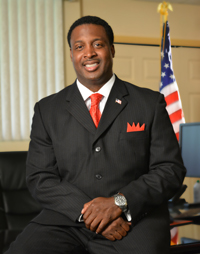 By Dr. Swannie Jett, DrPH, MSc, NACCHO Immediate Past President and Health Officer for the Florida Department of Health in Seminole County
By Dr. Swannie Jett, DrPH, MSc, NACCHO Immediate Past President and Health Officer for the Florida Department of Health in Seminole County
A crisis is playing out on the streets of America’s communities. Gun violence is a major public health problem and a leading cause of premature death. The issue of gun violence was thrust into the national spotlight once again on Dec. 2, when a gunman killed 14 people at a health department in San Bernardino, CA, drawing worldwide media attention. Mass shootings have shaped national debates about mental illness and gun laws. The Federal Bureau of Investigation defines mass shootings as incidents where four or more people are killed or injured by gunfire.
Seventy-seven percent of mass killings involve a gun. According to the American Public Health Association (APHA), every year we lose over 30,000 people from firearm-related violence, and an additional 180,000 suffer from non-fatal injuries. In 2015, more than 350 mass shootings occurred in the United States.
According to an article by APHA entitled “Mental Illness, Mass Shootings, and the Politics of American Firearms,” deaths from gun violence are not the only problem. Mental, psychological, and physical injuries from gun violence affect hundreds of thousands of Americans each year. The article elaborates with the following excerpt:
“Most people who are injured after being shot will have a long-term emotional sequela, so that’s another 60,000 annually with a long-term mental illness, psychological distress. These numbers do not include family members, or the family members of the loved ones who died unexpectedly which is a traumatic event.”
The relationship between mental illness and violence is complex. Research suggests that mass shootings increase mental health stigma and emphasize negative stereotypes. These negative stereotypes are pervasive and persistent in our society. According to the American Psychiatric Association, violence by people with mental health issues, such as schizophrenia or bipolar disorder, is rare and accounts for five percent of violent acts. People with a diagnosed mental illness cannot be blamed for all mass shootings. Growing evidence suggests that demographic and economic factors, such as being young, male, and of lower socioeconomic status, are major determinants of violence.
Gun violence affects people of all ages and races in the United States, but has a disproportionate impact on young adults, males, and racial/ethnic minorities. According to APHA’s Gun Violence Prevention Fact Sheet, among U.S. residents ages 10 to 29, homicide is the fourth leading cause of death for non-Hispanic Caucasians, the second leading cause of death for Hispanics, and the leading cause of death for non-Hispanic African Americans.
Dr. Georges Benjamin, President of APHA, recently published an article entitled “Gun Violence is an Epidemic. It is Time for a Public Health Response.” Dr. Benjamin’s article states that the epidemic of intentional gun violence can be reversed with a science-based approach. His stance is supported with the following statement:
“To reverse the gun violence epidemic—and it’s important that we use the word ‘epidemic’—we need to do the same thing we’d do for any infectious disease outbreak. We should track it, find the root causes, use science to find research gaps, create policy solutions and use mass public education campaigns to eradicate the threat.”
For years, policymakers have discussed a variety of prevention policies including universal background checks for gun purchasers, a ban on military-style assault weapons and high-capacity ammunition magazines, and a crackdown on gun trafficking through increased enforcement and penalties. However, policies must work together to target the diverse web of causal pathways that are involved with the problem. I urge policymakers to develop multi-faceted strategies to improve public safety, respect persons with serious mental illness, and continue to protect rights of lawful gun owners.
NACCHO supports an individual’s right to own and use firearms for legal purposes. NACCHO also recognizes the burden and impact of firearm-related injury and death as a national public health issue. NACCHO also underscores the importance of addressing the root causes of inequities (e.g., racism, sexism, classism) that result in racial and ethnic minority populations bearing a disproportionate burden of firearm-related morbidity and mortality.
Gun violence is not inevitable. It can be prevented through a comprehensive public health approach that keeps families and communities safe. NACCHO supports core public health activities necessary to eradicate gun violence: (1) conducting surveillance to track firearm-related deaths, determine causes, and assess intervention methods; (2) identifying risk factors associated with gun violence (e.g., poverty and depression) and resilience or protective factors that guard against violence (e.g., youth access to trusted adults); (3) developing, implementing, and evaluating interventions to decrease risk factors and build resilience; and (4) institutionalizing successful prevention strategies.
Currently, the Centers for Disease Control and Prevention are prohibited from using their funding to conduct research on firearm violence. However, other federal agencies such as the National Institute of Justice and National Institutes of Health have funding to research firearm violence. Several laws have effectively restricted federally funded research related to gun violence, as well as access to complete crime gun data. According to APHA’s Gun Violence Fact Sheet, minimal evidence is available that shows right-to-carry laws increase or decrease violent crime. The collection of data and research is imperative to understand causes and develop effective solutions.
An estimated 270 million to 370 million firearms are in circulation in the United States. According to the Census Bureau, approximately 318.9 million people live in the United States; that means there is nearly one firearm for every American.
The time is now for us to take action.
Resources
NACCHO Policy Statement: Prevention of Firearm-Related Injury and Death
http://www.naccho.org/uploads/downloadable-resources/99-03-firearm-control.pdf
NACCHO Policy Statement: Public Health, Racism, and Police Violence
http://www.naccho.org/uploads/downloadable-resources/15-04-Public-Health-Racism-and-Police-Violence.pdf
NACCHO’s Roots of Health Inequity Course
http://rootsofhealthinequity.org/
Police Killings and Police Deaths Are Public Health Data and Can Be Counted, PLOS Medicine
http://journals.plos.org/plosmedicine/article?id=10.1371/journal.pmed.1001915
The Prevention Institute: Preventing Violence and Reducing Injury
http://www.preventioninstitute.org/focus-areas/preventing-violence-and-reducing-injury








